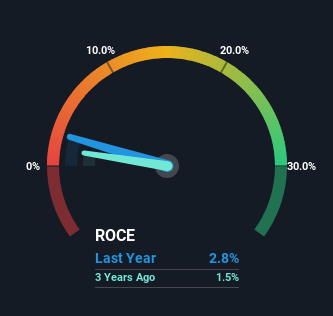- Canada
- /
- Oil and Gas
- /
- TSX:BIR
Here's What's Concerning About Birchcliff Energy's (TSE:BIR) Returns On Capital
What underlying fundamental trends can indicate that a company might be in decline? More often than not, we'll see a declining return on capital employed (ROCE) and a declining amount of capital employed. Ultimately this means that the company is earning less per dollar invested and on top of that, it's shrinking its base of capital employed. So after glancing at the trends within Birchcliff Energy (TSE:BIR), we weren't too hopeful.
Return On Capital Employed (ROCE): What Is It?
Just to clarify if you're unsure, ROCE is a metric for evaluating how much pre-tax income (in percentage terms) a company earns on the capital invested in its business. The formula for this calculation on Birchcliff Energy is:
Return on Capital Employed = Earnings Before Interest and Tax (EBIT) ÷ (Total Assets - Current Liabilities)
0.028 = CA$86m ÷ (CA$3.2b - CA$126m) (Based on the trailing twelve months to March 2024).
Thus, Birchcliff Energy has an ROCE of 2.8%. Ultimately, that's a low return and it under-performs the Oil and Gas industry average of 8.7%.
View our latest analysis for Birchcliff Energy

In the above chart we have measured Birchcliff Energy's prior ROCE against its prior performance, but the future is arguably more important. If you're interested, you can view the analysts predictions in our free analyst report for Birchcliff Energy .
How Are Returns Trending?
In terms of Birchcliff Energy's historical ROCE movements, the trend doesn't inspire confidence. About five years ago, returns on capital were 6.8%, however they're now substantially lower than that as we saw above. And on the capital employed front, the business is utilizing roughly the same amount of capital as it was back then. This combination can be indicative of a mature business that still has areas to deploy capital, but the returns received aren't as high due potentially to new competition or smaller margins. If these trends continue, we wouldn't expect Birchcliff Energy to turn into a multi-bagger.
The Bottom Line
In summary, it's unfortunate that Birchcliff Energy is generating lower returns from the same amount of capital. Since the stock has skyrocketed 163% over the last five years, it looks like investors have high expectations of the stock. Regardless, we don't feel too comfortable with the fundamentals so we'd be steering clear of this stock for now.
One final note, you should learn about the 2 warning signs we've spotted with Birchcliff Energy (including 1 which is concerning) .
For those who like to invest in solid companies, check out this free list of companies with solid balance sheets and high returns on equity.
Valuation is complex, but we're here to simplify it.
Discover if Birchcliff Energy might be undervalued or overvalued with our detailed analysis, featuring fair value estimates, potential risks, dividends, insider trades, and its financial condition.
Access Free AnalysisHave feedback on this article? Concerned about the content? Get in touch with us directly. Alternatively, email editorial-team (at) simplywallst.com.
This article by Simply Wall St is general in nature. We provide commentary based on historical data and analyst forecasts only using an unbiased methodology and our articles are not intended to be financial advice. It does not constitute a recommendation to buy or sell any stock, and does not take account of your objectives, or your financial situation. We aim to bring you long-term focused analysis driven by fundamental data. Note that our analysis may not factor in the latest price-sensitive company announcements or qualitative material. Simply Wall St has no position in any stocks mentioned.
About TSX:BIR
Birchcliff Energy
An intermediate oil and natural gas company, engages in the exploration, development, and production of natural gas, light oil, condensate, and other natural gas liquids in Western Canada.
Solid track record with excellent balance sheet.
Market Insights
Community Narratives



